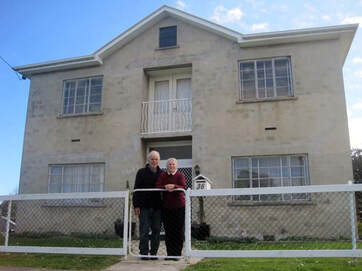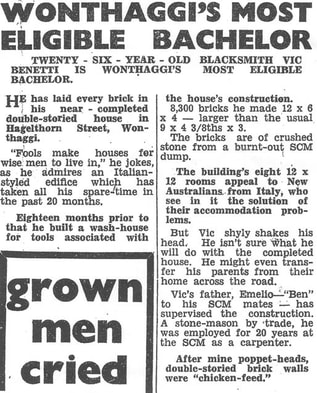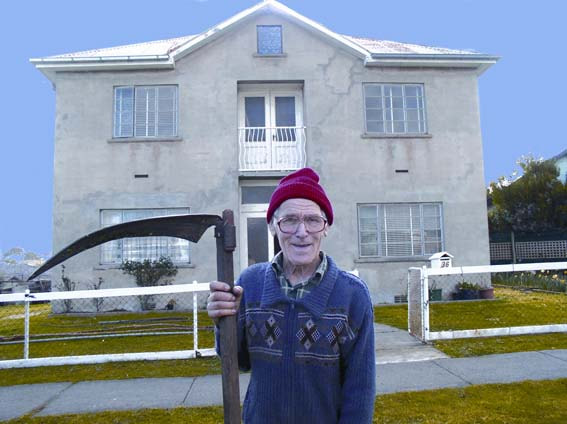 Victor and Maureen Benetti in their Hagelthorn Street house, 60 years after that article.
Victor and Maureen Benetti in their Hagelthorn Street house, 60 years after that article. By Catherine Watson
AN article in The Powlett Express of October 15, 1953, opens with the bold statement: “Twenty-six-year-old blacksmith Vic Benetti is Wonthaggi's most eligible bachelor”.
What made him so eligible, according to the article, was his almost-completed house in Hagelthorn Street. Vic, then a farrier at the State Coal Mine, had hand-made and laid 8300 bricks for the double-storeyed house, which he built across the road from his parents’ home.
When the Bass Coast Post calls at Mr Benetti’s house almost 60 years later, he recalls the article exactly. He’s got the clipping in a scrapbook. “Tom Ganon [Express editor] wrote it,” he said. Gannon also sent it to a Melbourne’s daily, The Argus, where it was printed it word for word.
AN article in The Powlett Express of October 15, 1953, opens with the bold statement: “Twenty-six-year-old blacksmith Vic Benetti is Wonthaggi's most eligible bachelor”.
What made him so eligible, according to the article, was his almost-completed house in Hagelthorn Street. Vic, then a farrier at the State Coal Mine, had hand-made and laid 8300 bricks for the double-storeyed house, which he built across the road from his parents’ home.
When the Bass Coast Post calls at Mr Benetti’s house almost 60 years later, he recalls the article exactly. He’s got the clipping in a scrapbook. “Tom Ganon [Express editor] wrote it,” he said. Gannon also sent it to a Melbourne’s daily, The Argus, where it was printed it word for word.
Vic doesn’t recall a conga line of single city women visiting from the city to seek out this most eligible of bachelors. In fact, it took him four more years to find the love of his life, Maureen, at a dance in the Berry’s Creek Hall.
Maureen recalls that a group of young blokes from Wonthaggi started coming to the dance and one of them became involved with a good friend of hers.
Maureen recalls that a group of young blokes from Wonthaggi started coming to the dance and one of them became involved with a good friend of hers.

The first time she went out on a date with young Victor was almost the last. “He took me out to Yarram. Coming back, he said he had to stop at a hotel.” She sat in the car while he went in and had a drink. “I thought that’s it. I wiped him off.”
Asked why he didn’t take Maureen in, Victor explains, “It was no place for a lady!” But he got the message. Maureen thought she’d given him the brush-off but he came back to the next dance and they made it up. Asked what it was about Maureen that he liked so much, he is overcome with emotion. “She was very down to earth,” he says. “I just reckoned she was it and a bit. I knew she was a very good person.”
For Maureen, marrying Vic meant leaving her lovely country lifestyle and moving to the comparatively urban Wonthaggi. “The people here were very nice. They took me out for an afternoon tea. Wonthaggi was a very friendly place then. People used to speak to one another, not like today.”
Victor Benetti had a reputation as one of the best farriers in the business. Locals said he only needed to look at a horse’s hoof to forge a perfectly fitting shoe for the mine ponies.
He worked as a blacksmith/farrier for more than 50 years, including some 30 years at the mine.
In 1988, in his early 60s and 20 years after the mines closed, he entered an international farriers’ challenge at Werribee Park. The 31 competitors in the Eagle Eye event had 10 seconds to study a horse’s hoof and 20 minutes to hand-work the shoe. Vic won in a canter, not because he was the fastest but because he was the most accurate.
It came from years of training. He was apprenticed to Norman Smith, one of Wonthaggi’s last general blacksmiths and farriers, when he was 15. “We did all sorts of iron work. I can remember us making a new dray wheel. It was five foot six inches diameter [almost two metres]. We rolled it up and had to bevel the two ends. We worked flat out while the welding heat lasted.”
After three years with Norman Smith, Vic finished his apprenticeship at the mines. He reckons he shoed horses from the age of 15 until the age of 73 or 74. “I dropped off towards the end,” he says. “I wouldn’t like to do it today. You’re up and down, and picking up the horse’s hoof. And they don’t always want to lift it up.”
These days he uses his energies around his garden and house. He is sometimes to be seen outside the house using his well-worn Austrian scythe to trim around his garden beds.
Fifty-five years down the track, he and Maureen have seven children: Catherine, Leo, Bernadette, Brendan, Philip, Anthony and Chris, 17 grandchildren and six or seven great-grandchildren, most of them living nearby.
They are still living in the distinctive Italian-styled house that Vic built. He’s not sure where the design came from – he thinks his father, who had been a stone mason in Italy, might have found the design in an Italian construction book. “I do know it took a lot of doing to get it built. It took us four or five years to finish it in our spare time and during the holidays.”
It has been a local landmark ever since. “People used to stop all the time to look at it,” Vic says. “Even now, people slow down when they go past.”
Asked why he didn’t take Maureen in, Victor explains, “It was no place for a lady!” But he got the message. Maureen thought she’d given him the brush-off but he came back to the next dance and they made it up. Asked what it was about Maureen that he liked so much, he is overcome with emotion. “She was very down to earth,” he says. “I just reckoned she was it and a bit. I knew she was a very good person.”
For Maureen, marrying Vic meant leaving her lovely country lifestyle and moving to the comparatively urban Wonthaggi. “The people here were very nice. They took me out for an afternoon tea. Wonthaggi was a very friendly place then. People used to speak to one another, not like today.”
Victor Benetti had a reputation as one of the best farriers in the business. Locals said he only needed to look at a horse’s hoof to forge a perfectly fitting shoe for the mine ponies.
He worked as a blacksmith/farrier for more than 50 years, including some 30 years at the mine.
In 1988, in his early 60s and 20 years after the mines closed, he entered an international farriers’ challenge at Werribee Park. The 31 competitors in the Eagle Eye event had 10 seconds to study a horse’s hoof and 20 minutes to hand-work the shoe. Vic won in a canter, not because he was the fastest but because he was the most accurate.
It came from years of training. He was apprenticed to Norman Smith, one of Wonthaggi’s last general blacksmiths and farriers, when he was 15. “We did all sorts of iron work. I can remember us making a new dray wheel. It was five foot six inches diameter [almost two metres]. We rolled it up and had to bevel the two ends. We worked flat out while the welding heat lasted.”
After three years with Norman Smith, Vic finished his apprenticeship at the mines. He reckons he shoed horses from the age of 15 until the age of 73 or 74. “I dropped off towards the end,” he says. “I wouldn’t like to do it today. You’re up and down, and picking up the horse’s hoof. And they don’t always want to lift it up.”
These days he uses his energies around his garden and house. He is sometimes to be seen outside the house using his well-worn Austrian scythe to trim around his garden beds.
Fifty-five years down the track, he and Maureen have seven children: Catherine, Leo, Bernadette, Brendan, Philip, Anthony and Chris, 17 grandchildren and six or seven great-grandchildren, most of them living nearby.
They are still living in the distinctive Italian-styled house that Vic built. He’s not sure where the design came from – he thinks his father, who had been a stone mason in Italy, might have found the design in an Italian construction book. “I do know it took a lot of doing to get it built. It took us four or five years to finish it in our spare time and during the holidays.”
It has been a local landmark ever since. “People used to stop all the time to look at it,” Vic says. “Even now, people slow down when they go past.”
